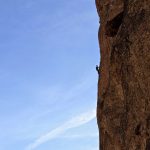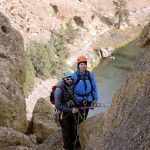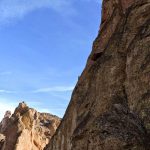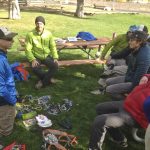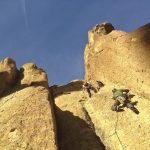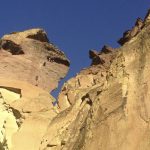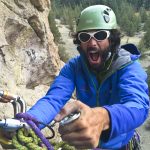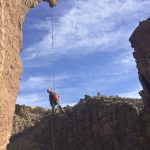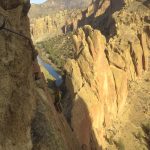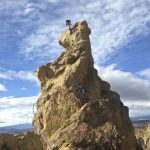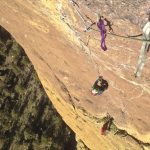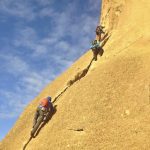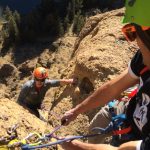Nate McKenzie on the takeaways from his 1st AMGA Course

Photos, video, & text by Black Diamond Scholarship winner Nate McKenzie. Read more about Nate in the latest issue of the GUIDE Bulletin.
It feels like the beginning of a long journey. Looking ahead at the courses, certifications, tuition, and exams required to become a fully-certified AMGA Mountain Guide is daunting. Or at least it was.
Having just completed the first step this month at Smith Rocks, I’m more excited and committed than ever to pursue full certification. The Rock Guide Course was an incredibly worthwhile learning experience and the first step in a process I’m excited to embark on.
I was fortunate to be placed in a strong group of students which allowed us to progress quickly through the curriculum and spend more time on advanced skills. There’s no question our instructors elevated the course beyond the curriculum. Marc Chauvin (Course Director), Peter Keene, and Kent McBride are uncommonly skilled guides, and they were incredibly generous mentors.

The awesome summit tower of the Cave Route (5.7) in high winds. Brogan Spire area in the Marsupial Crags.
At home in Connecticut I work independently at my own small business. Often missing in my own practice is the benefit of working with other professionals. AMGA instructors are an invaluable brain-trust which offer greater depth and context to the curriculum. There’s no replacement for the apprenticeship that takes place during a course like this.
I expected the greatest challenge of the course to be the physical strain of climbing 10 days in unfamiliar terrain. In fact, the greatest challenges were mental and involved absorbing new skills and ways of thinking. We learned to reexamine base systems I thought I had dialed. We learned to eschew recreational climbing habits and replace them with “more-elegant” and efficient guiding techniques and ways of thinking… not for techniques sake, but as a means of creating greater client reward and increasing safety for our guests and ourselves.
Takeaways: Here are a few nuggets of guiding wisdom gleaned as I review my notes. Each point deserves its own article but I’ll summarize some thoughts here.
- Risk management and client care “is the least we can do” for our guests. Guides work to
maximize client reward by balancing risk and comfort. - When making decisions weigh the benefit of risk – is it worth it?
- Not all bad decisions have bad consequences. Good decisions can have bad consequences.
- Consider career longevity – ease the strain on your body by improving your stance or using
body friendly tools (e.g. GriGri or GiGi). - Get involved. Apprentice Rock Guides job is to learn about the profession and become
certified. Someday we’ll lead the profession. - Analyze every process – do everything for a reason. Constantly improve your systems,
reduce clutter, and improve efficiency. - Manipulate your anchor to maximize the stance – not the other way around!
- Look for terrain patterns you can use.
A Remembrance:
Our group of eight students should have been nine. Liz Daley was enrolled in our group and recently passed away in an avalanche in South America. She was closely connected to our course, and her loss was felt as we consider the risks guides take in the mountains. Our community has lots a psyched, strong, and skilled female guides and aspiring guides. My sincere condolences to her friends and loved-ones.
The Right Tools:
No doubt having the best tools allows guides to increase safety margins and focus on creating rewarding experiences for our guests. A huge thank you to Black Diamond Equipment for supporting our profession through full-tuition scholarships for AMGA guides. Thank you to the awesome crew at Trailblazer and Denali, an independent outdoor retail chain back home for their support of Ascent Climbing, Paradox Sports, and local outdoor adventure.
- High on Sky Ridge (5.8 R) on Smith Rock Group. (Photo by Carter Grotbeck)
- Station management practice on Sky Ridge
- Leading Sky Ridge (5.8 R) on the Northeast Face of Smith Rock Group. (Photo by Carter Grotbeck)
- The guides backpack – Day 1 clinic with Peter Keene (foreground, left) and Marc Chauvin.
- Approaching Morning Glory Wall along the Crooked River in Smith Rock.
- Getting warmed up with some sunny, caterpillar-style multi-pitch climbing on Smith Rocks welded tuft.
- Smith Rock and the Cascade volcanoes in beautiful central Oregon.
- AMGA conga line on the aid pitch to the mouth on Monkey Face.
- Day 9 and 10 we woke to high winds and about 2 feet of snow in Terrebonne, Oregon.
- Smith Rock is home to spectacular sunrise and sunsets.
- Psyched!! Adam loving his job during the Rock Guide Course in Smith Rock.
- Belaying the second on Sky Ridge.
- An exercise in fall line management – the long traverse pitch on Sky Ridge (5.8 R)
- Descending the Monkey with a 160ft free-hanging rappel.
- Peter Keene (instructor) follows a traverse pitch on Sky Ridge (5.8 R) with the Monkey Face visible in the background.
- Topping out on Pack Animal (5.8 R) in the Fourth Horseman area.
- The awesome summit tower of the Cave Route (5.7) in high winds. Brogan Spire area in the Marsupial Crags.
- Adam learning to aid climb on the bolt ladder “Pioneer Route” on Monkey Face.
- Practicing parallel rope technique Spiderman (5.7) in 20 degree temperatures.
- Topping out on Pack Animal (5.8 R) in the Fourth Horseman area.

